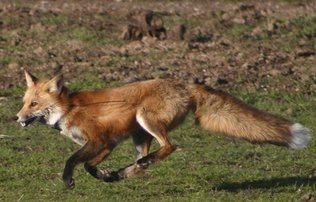Take action to help improve red fox conservation efforts
The red fox (Vulpes vulpes) is one of the most widely distributed terrestrial mammals in the world. California is home to red foxes of both native and non-native ancestry. Red foxes in the Sacramento Valley were long thought to be non-native. However, in 2005 genetic analyses performed in the UC Davis School of Veterinary Medicine’s, Veterinary Genetics Laboratory revealed these foxes to be native to the region and potentially in decline.
The estimated population size of Sacramento Valley (SV) red foxes is very small, indicating possible conservation concerns. In addition, SV red foxes occur in a highly modified landscape used for intensive agriculture. In particular, while preliminary analyses indicate that the current distribution of SV red foxes in the northern part of the Central Valley overlaps a floodplain once characterized by native grasslands and riparian forests, these habitats have been heavily modified to meet agricultural needs. The continuous modification of habitats for agriculture in the SV may be impeding on the limited habitats available to foxes, particularly since these foxes only live at low elevations.
Based on their unique natural history and their close proximity and dependency on human modified landscapes, SV red foxes face multiple threats. Direct threats include deaths attributed to a variety of causes: residents protecting their poultry, vehicle collisions, exposure to pathogens from domestic animals, and ingestion of poison bait meant for rodent control or eating rodents killed by poison. Additional threats for the viability of SV red foxes are the species’ limited range and distribution. Species isolated in a single region with a small population, like the SV red fox, experience minimal genetic variation in their gene flow, and could potentially face genetic introgression from adjacent non-native populations. These threats, which are likely increasing over time, may warrant placing the SV red fox on the threatened species list in the near future.
In 2007, an online reporting system was launched by the University of California, Davis, with goals of involving the public in documenting any potential fox sightings. The goal of this website was to involve the local community with locating SV red foxes so that samples could be obtained for genetic testing and surveillance could be set up for behavior monitoring.
Now, master's student Amy Brasch of Victoria University of Wellington is assessing how effective public input was on locating the foxes and how the website can be improved for future conservation efforts.
You are invited to share your opinions regarding red foxes and the fox sighting website in a 5-minute survey located on the fox sighting website: http://foxsurvey.ucdavis.edu/
The results of this survey will enhance the website as well as develop a better understanding of how effective public input is on locating Sacramento Valley red foxes.

Sacramento Valley fox pup. (Photo: Mark Statham)
Comments:
I live in Central Valley Ca. Springville. Foothills to Sierras and Sequoia National Park.
Fox ran along fence line and disappeared into orange grove.
we would like to assist this species to survive.... they are truly a beautiful creature!
Are there any animal protection regulations which I can use to thwart the Community Associations demand?


Posted by Rachael Long on October 19, 2012 at 3:41 PM